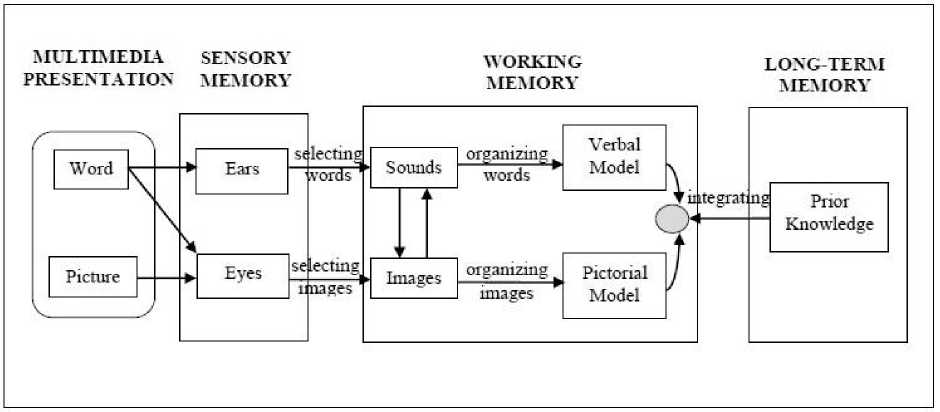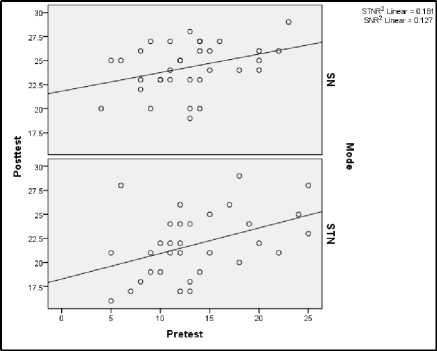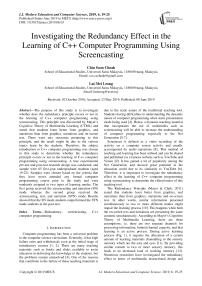Investigating the redundancy effect in the learning of C++ computer programming using screencasting
Автор: Chin Soon Cheah, Lai-Mei Leong
Журнал: International Journal of Modern Education and Computer Science @ijmecs
Статья в выпуске: 6 vol.11, 2019 года.
Бесплатный доступ
The purpose of this study is to investigate whether does the redundancy principle occurs or not in the learning of C++ computer programming using screencasting. This principle was discovered by Mayer’s Cognitive Theory of Multimedia Learning (CTML) and stated that students learn better from graphics, and narrations than from graphics, narrations and on-screen text. There were mix outcomes pertaining to this principle, and the result might be due to the various topics learn by the students. Therefore, the subject introduction to C++ computer programming was chosen in this study to determine whether the redundancy principle occurs or not in the learning of C++ computer programming using screencasting. A true experimental pre-test and post-test research design was conducted, and sample were 65 first-year undergraduate students (aged 19-22). Samples were chosen based on the criteria that they have never attended any formal computer programming course prior to the study and were randomly assigned to two types of learning modes. The first group received the screencasting and narration (SN) mode whereas the second group received the screencasting, text, and narration (STN) mode. Results showed that the SN mode students outperformed the STN mode students in the post-test.
Redundancy, screencasting, C++ computer programming
Короткий адрес: https://sciup.org/15016856
IDR: 15016856 | DOI: 10.5815/ijmecs.2019.06.03
Текст научной статьи Investigating the redundancy effect in the learning of C++ computer programming using screencasting
Published Online June 2019 in MECS DOI: 10.5815/ijmecs.2019.06.03
Computer programming has been a universal problem in the computer science curriculum. Generally, it has high failure rates and withdrawals even at the initial stage of introductory courses [1, 2]. There are many teaching materials such as books and slides available to assist educators in delivering the knowledge to the students, but the problems remain unresolved [3]. One of the reasons that contribute to the failure of these teaching materials is due to the static nature of the traditional teaching tool. Students having difficulties in understanding the dynamic nature of computer programming when static presentation mode being used [4]. Hence, a dynamic teaching material that incorporates the use of multimedia such as screencasting will be able to increase the understanding of computer programming especially to the Net Generation [5-7].
Screencast is defined as a video recording of the activity on a computer screen activity and usually accompanied by audio narrations [8]. This method of teaching and learning has been utilised and can be shared and published via a famous website such as YouTube and Vimeo [9]. It has gained a lot of popularity among the Net Generation, and showed great potential in the education world due to its similarity to YouTube [6]. Therefore, it is important to investigate the redundancy effect in the learning of C++ computer programming using screencasting to determine the effectiveness of this teaching tool.

Fig.1. Cognitive Theory of Multimedia Learning [11]
Traditional teaching methods using static material such as PowerPoint slides and books do not seem to be an effective teaching materials in the teaching of computer programming [18]. Moreover, the materials are unable to explain effectively the dynamic concept of computer programming. Due to that, students fail to understand the dynamic nature of computer programming whenever static materials are used to explain to them [19]. Hence, one of the teaching methods that fulfils most of the requirements in the learning of computer programming is by using screencast [18]. Screencast consists of dynamic elements that support spatial and visual capabilities that accommodate the nature of learning computer programming [19]. However, there are not much studies that can prove the effectiveness of screencast in the teaching of computer programming. Therefore, the researcher has decided to conduct this study to ascertain the effectiveness of screencasting in the teaching of C++ computer programming. Furthermore, the study is also conducted to determine whether the effect of redundancy principle do occur or not in the learning of C++ computer programming using screencast.
-
II. Related Works
It is a common belief by the majority of the population that the availability of a similar on-screen text with spoken narrations during a presentation is better for learners. However, this conclusion is not supported by much evidence. Evidently, the contrary happens and impairs the learning process when both on-screen text and narrations are used simultaneously [20]. As a result, the redundancy effect happens.
According to the research done by Sweller [21], the redundancy principle occurs when redundant material is presented and leads to an increase of extraneous cognitive load. This happens when learners not only required to attend to the core information, but also need to engage with irrelevant information which leads an increase of working memory [22]. Moreover, the redundancy effect creates an incidental process which reduces and distracts the learners focus on the main learning process [13]. Besides that, by having similar contents presented in two different modes such as narration and on-screen text, learners will have the tendency to compare the content between the two modes [20].
Past research conducted by Mayer and Moreno [23], on the learning of lighting formation process, the result showed that the redundancy effect does impaired the learning process. In the study, students were assigned to two different types of learning modes. The first group was assigned to the animation and narration mode, whereas the second group was assigned to the animation, narration and on-screen text mode. The result showed that the first group outperformed the second group in the problem-solving and transfer test. The outcome is also supported by the research done by Pachman and Ke [15] which used screen capture video as learning mode. In another study conducted by Aldalalah [24] in the learning of music theory also shown the same result. The result shows that the students which are given the audio and image mode performed better than the group of students that were given the text and image mode, and also the group of students that were given the audio, image and text mode. From the perspective of children learning process, pictures are found to be more of a distraction and attraction to children and hindered them from focusing on the core information [25].
Moreover, split-attention happens when a learner’s attention is divided to engage in both visual materials as well as on-screen text [14]. The split attention occurs even when the on-screen text is related to the video or pictures in a presentation [26]. Hence, in order to design an effective multimedia learning material, the leaner’s attention should not be split while engaging in verbal and pictorial contents simultaneously [27].
However, the redundancy principle is refuted based on a certain exceptional scenario. This is based on the different level of learners’ experience and the quality of the multimedia learning material. The presentation of onscreen text is required when the absence of pictorial information, complex spoken words used or contain unfamiliar words which hampered the understanding of the learners [16]. The outcome was supported by the research done by She, Wang [17] in the teaching of a foreign language. Findings show that the on-screen text supported the learning of new vocabulary and increases learning efficiency. Furthermore, beginners preferred diagrams that are included with text to assist them in relating the texts and diagrams together. However, experienced learners preferred diagrammatic explanation with minimal text [28]. Besides that, the quality of the audio narration plays an important factor as well. Low audio quality might decrease the clarity of the narration which makes it difficult for the learners to understand. Moreover, the presentation speed in terms of the time pace between the pictorial information and on-screen text need to be taken into consideration. Ample time is needed to allow the learners’ sufficient time to absorb the information channelling to the same sensory memory [20].
Based on past research findings, the redundancy effect does occur in much research studies involving various types of subjects such as music theory, and learning of lighting formation process [10, 24]. However, there is a lack of research in investigating the redundancy effect in the learning of the subject computer programming. Hence, the objective of this study is to ascertain whether the redundancy effect occurs or not in the field of computer programming.
-
III. Screencasting
There were two modes of screencasting used in this research. The screen and narration (SN) mode and the screen, text and narration (STN) mode. In the SN mode, information is presented in screen recording with narration. The screen recording provides relevant information such as keywords, images, programming codes, and animated graphics on the screen. At the same time, narrative explanations are provided simultaneously as well. Therefore, there are no captions below the screen to provide textual explanations. Instead, explanations are provided through narrations along with the screencast.
In the STN mode, information is presented in screen recording, text, and narration. The screen recording provides relevant information such as keywords, images, programming codes and animated graphics on the screen. At the same time, captions of textual explanations and narrative explanations are provided simultaneously as well. This treatment mode is used to examine the impact of the redundancy principle. According to the redundancy principle, learning is less effective when redundant materials such as on-screen text that is identical to the spoken narrations are shown simultaneously during the presentation. This causes cognitive overload and impaired learning [20]. Thus, the STN mode was designed by providing the narrations and on-screen text simultaneously to examine the impact of the redundancy principle.
-
IV. Methodology
The sample consists of 65 first-year undergraduate students (age 19-22) which have never taken before any formal computer programming courses. Students were randomly assigned into two groups. The first group received the SN mode (Fig. 2) where information is presented in screen recording and narration. Hence there were no captions below the screen to provide contextual explanations. Meanwhile, the second group received the STN mode (Fig. 3) where information is presented in screen recording, text, and narration. The text is the captions included below the screen which has similar information as the audio narration.
Topic 4 Introduction to Functions
Example:
// local variable declaration int result:
// function returning the max between two numbers Sint max(int numl, int num2)

Listing 4.1 Program showing the function of returning bigger number
Fig.2. Screen and narration mode (SN)
topic 4: Introduction to Functions
Example:
// function returning the max between two numbers Bint max(int numl, int num2)

Listing 4.1 Program showing the function of returning bigger number
This variable is use to hold the returning value of the “max” function, which will be sent back to the main function.
-
Fig.3. Screen, text and narration mode (STN)
Students from both groups attempted the C++ computer programming pre-test which consists of 30 multiple-choice questions. After that, students viewed the screencast for five consecutive weeks where each week a new topic was introduced. Each group is given an hour to view their respective mode of the screencast. In the final week, students were given the C++ computer programming post-test to assess their achievement after viewing all the five screencasts. The questions in the post-test were the same as the pre-test questions except for the sequencing of the questions number were jumbled up to avoid the students memorising the answers from the pre-test. The pre-test has been tested based on the Kuder-Richardson reliability test, and the KR20 results of 0.78 was obtained. This indicates that the internal reliability of the test was at an acceptable level.
-
V. Results
The Mean and Standard Deviation of the C++ Computer Programming Pretest and C++ Computer Programming Post-test scores of the sample classified according to the SN mode, STN mode is shown in Table 1. The results show that the mean and standard deviation obtained for the SN mode are (M = 14.24, SD = 4.98), whereas the mean and standard deviation obtained for the STN mode are (M = 14.03, SD = 5.63). The mean of C++ Computer Programming Post-test for the SN mode is higher compared to the mean of the STN mode. Hence, the result shows that the SN mode is more effective compared to the STN mode.
Table 1. Mean and Standard Deviation of the C++ Computer Programming Pretest and C++ Computer Programming Post-test
|
Group |
N |
C++ Computer Programming Pre-test |
C++ Computer Programming Post-test |
||
|
Mean |
Std. Deviation |
Mean |
Std. Deviation |
||
|
SN |
33 |
14.24 |
4.98 |
24.27 |
2.60 |
|
STN |
32 |
14.03 |
5.63 |
23.63 |
3.09 |
Before an Analysis of Covariance (ANCOVA) is conducted, four assumptions need to be ascertained to ensure that the data can actually be analysed using ANCOVA. The assumptions that need to fulfilled are (i) Homogeneity of Slope, (ii) Linearity among Dependent Variable and Covariate, (iii) Normality of Distribution and (iv) Homogeneity of Variance [29]. The results of the four assumptions as below.
Assumption 1: Homogeneity of Slope
The result F(1,61) = .27, p = .60 which is nonsignificant. Therefore, it does not violate the assumption because it is a non-significant interaction between the C++ Computer Programming Pretest and the two treatment groups (Table 2).
Table 2. Homogeneity of Slope between Mode and C++ Computer Programming Pretest
Assumption 2: Linearity among Dependent Variable and Covariate
The result shows that there is a linear relationship between the dependent variable and covariate. The linear value for the SN = 0.13 and the linear value for STN = 0.18 (Fig. 4). Therefore, it does not violate the assumption of linearity among the dependent variable and covariate.
Assumption 3: Normality of Distribution
The C++ Computer Programming Pretest value for the skewness is 0.52, whereas the value of the kurtosis is -0.15. The C++ Programming Posttest value for the skewness is -0.25, whereas the value of the kurtosis is -0.69 (Table 3). All the values of skewness and kurtosis are between +1/-1. Therefore, the variables are normally distributed.

Fig.4. Scatter plot showing the linearity relationship between the dependent variable and covariate for Mode
Table 3. Normality of Distribution of C++ Computer Programming Pretest and C++ Computer Programming Posttest
|
Skewness |
Kurtosis |
|
|
C++ Computer Programming Pretest |
.519 |
-.150 |
|
C++ Computer Programming Posttest |
-.248 |
-.692 |
Assumption 4: Homogeneity of Variance
The result from Levene’s Test for homogeneity of variance by comparing the dependent variables among the two treatment modes for each variable shows that homogeneity of variance was met. The result of p > 0.05 shows that the groups were homogenous (Table 4).
Table 4. Homogeneity of variance
|
Variable |
F |
df1 |
df2 |
Sig. |
|
Mode |
1.153 |
1 |
63 |
.287 |
|
Logic |
1.184 |
1 |
63 |
.281 |
Analysis of two-way ANCOVA was conducted to determine the significant difference in the students’ achievement between those using SN and STN mode. The C++ Computer Programming Pretest score is set as the covariate and the results are shown in Table 5. The results show that there is a significant difference in the students’ achievement in the learning of C++ computer programming between those using SN and STN mode, F(1,60) = 19.28, p = .00, η2 = .24.
-
VI. Discussion
The result shows that students receiving the SN mode attained better C++ Computer Programming Post-test score compared to the students who received the STN mode. The ineffectiveness of the STN mode might be due to the Redundancy Principle.
In the STN mode, similar information has been presented simultaneously in text and narration. This leads to the increased load of the working memory [10]. By overloading the working memory it has impaired the learning process. Therefore, some of the unprocessed information is rejected and learning fails. Moreover, split attention happens when students’ attention is divided to engage in both visual images as well as on-screen text [14]. Hence students were unable to understand and failed to achieve optimum learning [12].
Contrary to STN mode, the SN mode presented the visual images channelled to the eye and the narration channelled to the ear. The balance between the visual and auditory channels allows ample resources to select and organise the visual and verbal information into meaningful verbal and pictorial model [30]. Thus, it reduces and minimises the cognitive load and prevent the overloading of the extraneous cognitive load from happening [31].
-
VII. Conclusion
Therefore, the significant difference in the students’ achievement in learning C++ computer programming between the SN and STN modes has shown that it supported Mayer’s Cognitive Theory of Multimedia Learning. The results show that the redundancy effect does occur in the learning of introduction C++ computer programming using screencast.
This can be explained according to Mayer and Moreno [10], whereby the redundancy effect occurs when a multimedia presentation consisting of similar information being presented simultaneously in two or more different modes. This happens in the screen, text, and narration (STN) mode where similar information of the narrations is presented simultaneously as on-screen text as well. It impairs the learning process, as the additional information provided is unrelated and redundant. Due to that, it increases the load of the working memory.
Moreover, split attention happens when the learners’ attention is divided to engage in visual materials as well as on-screen text [14]. This even happens when the onscreen text is related to the videos or pictures shown in the presentation [26].
Besides that, the findings have also provided further insight into the development of an effective instructional design tool. When creating an instructional multimedia learning courseware, a designer needs to take into consideration the redundancy effect to prevent it from overloading the extraneous cognitive load.
Список литературы Investigating the redundancy effect in the learning of C++ computer programming using screencasting
- Butler M, Morgan M, editors. Learning challenges faced by novice programming students studying high level and low feedback concepts. Proceedings of Ascilite; 2007; Singapore.
- Robins A, Rountree J, Rountree N. Learning and Teaching Programming: A Review and Discussion. Computer Science Education. 2003;13(2):137-72.
- Tan P-H, Ting C-Y, Ling S-W, editors. Learning difficulties in programming courses: undergraduates' perspective and perception. Computer Technology and Development, 2009 ICCTD'09 International Conference on; 2009: IEEE.
- Ismail MN, Ngah NA, Umar IN. Instructional strategy in the teaching of computer programming: A need assessment analyses. TOJET. 2010;9(2):125-31.
- Barnes K, Marateo RC, Ferris SP. Teaching and learning with the net generation. Innovate: Journal of Online Education. 2007;3(4):1.
- Beyers RN. A five dimensional model for educating the net generation. Educational Technology & Society. 2009;12(4):218-27.
- Hargittai E. Digital na (t) ives? Variation in internet skills and uses among members of the “net generation”. Sociological inquiry. 2010;80(1):92-113.
- Udell J. Name that genre: Screencast 2004 [2005]. Available from: http://jonudell.net/udell/2004-11-17-name-that-genre-screencast.html.
- Mohorovičić S, Tijan E, editors. Using Screencasts in Computer Programming Courses. Proceedings of the 22nd EAEEIE Annual Conference, Maribor; 2011; Slovenia.
- Mayer RE, Moreno R. Nine ways to reduce cognitive load in multimedia learning. Educational psychologist. 2003;38(1):43-52.
- Mayer RE. Multimedia learning. Psychology of Learning and Motivation. 2002;41:85-139.
- Mayer RE. Principles for managing essential processing in multimedia learning: Segmenting, pretraining, and modality principles. Cambridge handbook of multimedia learning. 2005:169-82.
- Tempelman-Kluit N. Multimedia learning theories and online instruction. College & Research Libraries. 2006;67(4):364-9.
- Cierniak G, Scheiter K, Gerjets P. Explaining the split-attention effect: Is the reduction of extraneous cognitive load accompanied by an increase in germane cognitive load? Computers in Human Behavior. 2009;25(2):315-24.
- Pachman M, Ke F, editors. Screen captured video tutorials as a special case of multimedia: testing the redundancy principle. E-Learn: World Conference on E-Learning in Corporate, Government, Healthcare, and Higher Education; 2009.
- Mayer RE, Johnson CI. Revising the redundancy principle in multimedia learning. Journal of Educational Psychology. 2008;100(2):380.
- She J-H, Wang H, Chen L, Chen S. Improvement of redundancy principle for multimedia technical foreign-language learning. International Journal of Computer Applications in Technology. 2009;34(4):264-9.
- Bennedsen J, Caspersen ME, editors. Revealing the programming process. ACM SIGCSE Bulletin; 2005: ACM.
- Gomes A, Mendes AJ, editors. Learning to program-difficulties and solutions. International Conference on Engineering Education–ICEE; 2007.
- Mayer RE, Clark RC. E-learning and the science of instruction: Proven guidelines for consumers and designers of multimedia learning. 2011.
- Sweller J. The Redundancy Principle in Multimedia Learning. The Cambridge Handbook of Multimedia Learning. Cambridge, Estados Unidos: Cambridge University Press; 2005.
- Chandler P, Sweller J. Cognitive load theory and the format of instruction. Cognition and instruction. 1991;8(4):293-332.
- Mayer RE, Moreno R. Aids to computer-based multimedia learning. Learning and instruction. 2002;12(1):107-19.
- Aldalalah MO. Effects of modality principle on the learning of music theory and attitude among primary pupils of different aptitudes in Jordan. Unpublished PhD Thesis, Universiti Sains Malaysia, Penang. 2010.
- Diao Y, Sweller J. Redundancy in foreign language reading comprehension instruction: Concurrent written and spoken presentations. Learning and Instruction. 2007;17(1):78-88.
- Moreno R, Mayer RE. Cognitive principles of multimedia learning: The role of modality and contiguity. Journal of educational psychology. 1999;91(2):358.
- Mayer RE. The Cambridge handbook of multimedia learning: Cambridge University Press; 2005.
- Sorden SD. A cognitive approach to instructional design for multimedia learning. Informing Science: International Journal of an Emerging Transdiscipline. 2005;8:263-79.
- Myers JL, Well A, Lorch RF. Research design and statistical analysis. New York, NY: Routledge; 2010.
- Mayer RE. Cognitive theory of multimedia learning (pp. 31-48). University of California, Santa Barbara2005. 31-48 p.
- Mayer RE. Cognitive theory of multimedia learning (pp. 31-48). Santa Barbaras, California: University of California; 2005. 31-48 p.


